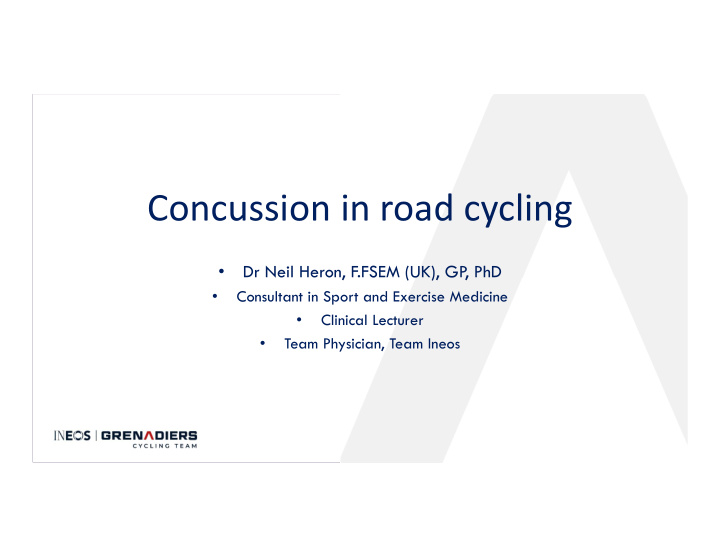



Concussion in road cycling Dr Neil Heron, F.FSEM (UK), GP , PhD • Consultant in Sport and Exercise Medicine • Clinical Lecturer • Team Physician, Team Ineos •
Sports ‐ related concussion (SRC) SRC gaining wider public recognition • Decock, BJSM – 7.8 - 9.1% of all injuries • reported Road cycling - no sport-specific SRC diagnosis • and management protocols High-profile cases of professional road cyclists • who likely suffered SRC in a race but continued to participate Particularly highlighted the lack of a roadside • screening (“go/no go”) assessment protocol Propose a RoadsIde heaD injury AssEssment • (RIDE) protocol, consistent with other sports
Tom Skujins Tour of California 2017 ‐ crash
PRACTICAL CONSIDERATIONS IN ROAD CYCLING….
ROMAIN BARDET, STAGE 13 ‐ CRASH ‐ TOUR DE FRANCE, 2020
WHAT’S THE EVIDENCE BASE FOR CONCUSSION IN ROAD CYCLING?
SPORTS ‐ RELATED CONCUSSION (SRC) IN ROAD CYCLING: THE ROADSIDE HEAD INJURY ASSESSMENT (RIDE) FOR ELITE ROAD CYCLING
Evaluation Serial clinical evaluations by a health • professional Within a three-stage process • RIDE 1 - Assess the cyclist immediately • road-side after the head impact event; RIDE 2 - Re-assess the cyclist • immediately after the race is complete on the same day of the injury; RIDE 3 - Re-assess the cyclist the day • following the initial injury.
CYCLING ROADSIDE HEAD INJURY ASSESSMENT (RIDE) PROTOCOL
RIDE 1 The three components of RIDE 1 are: Presence/absence of 12 Immediate and • Permanent Removal features; Presence/absence of 11 high risk features; • A standardised road side screening • assessment performed by the race and/or team doctor including: symptom checklist, – medical evaluation, – balance assessment and – cognitive tests; – Clinical evaluation/discussion by the race • doctor and/or team doctor.
RIDE 2 and 3 Neurological exam • SCAT 5 (same language as baseline) • DSST •
Diagnosing SRC The RIDE protocol - SRC diagnosis is • made immediately on identification of any of the 12 Immediate and Permanent Removal features following a head impact event In the absence of any of the 12 • Immediate and Permanent Removal features, SRC diagnosis cannot be excluded until both RIDE 2 and RIDE 3 assessments are completed and deemed to be normal
RETURN TO RIDE PROTOCOL
Practical Considerations for implementing the RIDE ‐ UCI Who should perform the in-race RIDE1 and post-race • RIDE 2 assessments? Multiple casualties? • Time needed for the RIDE 1 assessment during the race • and impact on individuals result/performance? Consistent application of RIDE across the road cycling • geographical and medical landscapes Challenge - language barriers – Appropriate education programme for riders, • management, race and team medical staff Learn from rugby – Briefing of the media and viewing public • Baseline testing? • UCI monitor the application of the RIDE to avoid any • potential abuses of the system Role of non-medics • E.g. neutral service – Other cycling disciplines? •
Conclusion Recognise this is a ‘first step’ in this process • of establishing a SRC protocol Encourage discussion and debate with the • sporting community involved in road cycling and other sports Experts in SRC management in other sports • Encourage leadership from UCI • Invitation to participate in SCAT • guidelines….. RIDE protocol will be refined and updated • with analysis of use and as new evidence emerges.
Recommend
More recommend